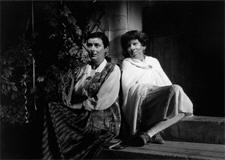 |


|
|
|
|
By John Demetry
Roy Cohn / Jack Smith; What's Underground About Marshmallows? and Waiting for the Moon
Vawter's performance is undoubtedly awe-inspiring; and our fascination with it sustains the video. He plays Roy Cohn as playwrite Gary Indiana imagines his speech before the American Society for the Protection of the Family. This is an audacious setting, showing us the Cohn of public infamy. His unleashes his vitriolic attacks on "the Reds" and "the Gay Rights Movement" in comic snarls. Cohn's double life as a closeted homosexual gives the piece its comic edge -- but also, in an act of artistic sympathy--its emotional, tragic undercurrent. When Vawter introduces the Roy Cohn/Jack Smith piece to the live audience, he becomes too emotional to continue and has to start over again. He says, "I made the classic actor's mistake. I thought about what I was saying." Thanks to Godmilow's documentation of Vawter behind the scenes, Vawter's personal confession heightens the emotional and thematic impact of the rest of his performance. This "actor's mistake" becomes the dramatic crux of the “Cohn” section. Cohn quotes Tennyson: "Until we pass and reach that other, where we will see as we are seen." At that moment, Cohn begins to look at himself from the outside, to think about what he is saying. He takes a moment of reflection, and to drink some water to revitalize that actor's tool. He returns to the podium with a dramatic flair.
Smith declares to his audience: "Nobody thinks I'm acting. If you couldn't move in you theatre seats, if you couldn't tear your eyes off of the actor, well then it must be good acting." We get the point that our hypnotized fascination with the Cohn speech was an appreciation of the spectacle of pathetic evil. And we understand that the gay spectacle of "coming out" is a necessary political act.
As already noted, the scenes of Vawter before his performances heightens the themes. It makes the documentation of the performance even more poignant, tying Vawter's own relationship to performance with the performances given by his two subjects. Watching him practice his inflections for certain lines in Roy Cohn shows him putting himself in Cohn's position. He understands how Cohn worked his New York Jewish accent for optimal sway on his audience. The shots of the audience probably help alert us to Godmilow's decision to cross-cut between the two pieces. She mimics the process of making connections between the two. However, as the video release of the uninterrupted What's Underground About Marshmallows? reveals, Godmilow sacrifices much to this technique. Seen completely, the Smith magic -- even truncated -- works its spell. We become involved in Vawter's/Smith's posing in the kitsch Arabian setting - think Cecil B. DeMille made as banal as a living room. His mind wanders through a bizarre fantasy of safe-kept underground filmmakers. It's practically a glam manifesto of personal liberation through artifice. Still, it's a shame that it wasn't released with the uninterrupted Roy Cohn preceding it. As Vawter explains: "These two plays were meant to be seen together." Maybe Roy Cohn is locked away in the same safe as all those poor underground filmmakers. Both of these videos are essential viewing for people interested in aesthetics, politics, acting, or gay history -- specifically because of the extent to which they record Vawter's second-to-last performance. Together, they bring up a powerful issue worth arguing about. How can the camp aesthetic of Jack Smith compete with the sentimental allure of American virtues that Cohn twists into hate? At odds are the pop humanism of co-producer Jonathan Demme (director of unheralded masterpiece Beloved) and the artsy elitism of co-producer James Schamus (whose latest bore Crouching Tiger, Hidden Dragon has been nominated for Oscar's Best Picture). Godmilow takes sides. Her foo-foo approach offers no alternative to the pleasure of performance.
Baring the weight of playing "a saint," Linda Hunt infuses Toklas with her singular humor and baring. She puts up with the "genius" Stein's (Linda Bassett) cutting criticisms because she loves her and trusts that Stein feels the same. Godmilow and her actresses create a delicate portrait of a relationship with a stubborn, selfish intellectual. Godmilow wisely begins the film with Toklas proofreading while Stein reads her latest aloud. The camera makes repeated semi-circle tracks, finding a visual equivalent to Stein's modernist wordplay. We get a sense of their affection expressed through the process of Stein's art. That art was created amidst the American Lost Generation and the French Bohemians that expatriate Stein helped bring together. The focus on Toklas and Stein reveals the way all of these artists expressed a depth of understanding of their time in art, yet were foolish, cold or even cruel, in their personal lives. Perhaps that's the theme running through Godmilow's three videos. These flaws actually drive her own challenging, frustrating, and fascinating art. You can't fault that level of self-perception. |

© 1997-2002 BEI
 Jill Godmilow
Jill Godmilow  Roy Cohn/Jack Smith
Roy Cohn/Jack Smith Waiting for the Moon
Waiting for the Moon